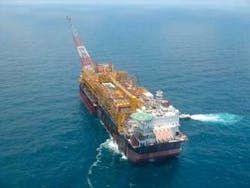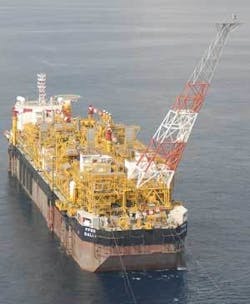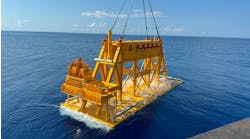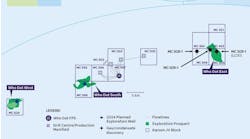Late last year, oil started flowing from Total’s second production center in Angola’s block 17. Dalia, like its forerunner Girassol, is being developed via one of the world’s largest FPSOs linked to an extensive network of deepwater subsea wells.
There the similarities end, however. Dalia’s shallower subsurface location presented greater difficulties in well design, due to the need for a steeper drilling radius, and the field’s extent would require twice as many wells to develop. Also, its Miocene crude is much heavier than Girassol’s Oligocene oil, and cooler on outflow. This would necessitate more intensive flow assurance measures, both to safeguard passage of fluids to the FPSO at the correct temperature, and to counter hydrates build-up during shut-downs.
Prior to its merger with Total, Elf discovered Dalia in September 1997, as part of a prolonged drilling campaign in the previously undrilled deepwater block 17. The field, 230 sq km (89 sq mi) in area, is situated 135 km (84 mi) offshore Angola’s northern coast, in water depths varying from 1,200 to 1,500 m (3,937 to 4,921 ft). Recoverable reserves are estimated at close to 1 Bbbl of oil.
Dalia’s four main reservoirs were formed over 25 million years ago following the accumulation of sediments at the mouth of the Congo River. Over time, periodic subsea avalanches shifted these sediments out to the deep offshore, where they were deposited in and along the edges of seabed channels.
Today the turbiditic, unconsolidated and heterogeneous reservoir sands, lying at a subsurface depth of 800 m (2,625 ft), are several kilometers long, with varying thickness. All contain viscous and acidic crude (21-23° API), with relatively low outflow temperatures of 45-50° C.
According to Dalia’s project director, Daniel Picard, Total started preliminary analysis of the field and its geology in 1998. One of the main preoccupations was resolving uncertainties over the sediment composition: Clay deposits cause compartmentalization in Dalia’s reservoir sands, in turn constraining connectivity and hampering oil flow.
During the project’s conceptual stages, ABB in Den Haag performed basic engineering, but Total’s in-house team managed subsequent engineering studies, before submitting the final development plan to Sonangol in 2002. From the outset, says Picard, insulation of subsea equipment was the overriding concern for Elf and its block 17 partners ExxonMobil, BP, Statoil, and Hydro.
Development options
Angola’s government sanctioned a development plan in May 2003. The subsea production system, awarded early on to Kvaerner Oilfield Products, would be one of the world’s largest for a deepwater project, with a base case of 67 wells, comprising 34 producers, 30 water injectors and three gas injectors (two to be converted later on for water injection). There would be an option to expand the total to 71 wells, should the partners decide to tie in the nearby Miocene accumulation Camellia.
Due to the relatively shallow subsurface depth, all would be highly deviated - near-horizontal within the reservoirs - with an average drain length of 1,100 m (3,609 ft), and drill-through horizontal christmas trees. These wells would be tied into nine manifolds connecting 40-km (25 mi) of 305 mm (12-in.) pipelines in four production loops, to maximize coverage on the seabed. Produced fluids would head to the FPSO through eight flexible production riser bundles; reservoir drive would be assisted by four 305-mm (12-in.) water injection lines and associated risers, and two 305 mm (12-in.) gas injection flowlines, with 75 km (47 mi) of steel tube, control/power umbilicals.
Technip secured a contract for the umbilicals, risers, and flowlines, manufacture being split among the company’s flexible pipe production center in northern France and its new umbilical plant in Angola. Technip was also contracted for pre-installation of the FPSO’s mooring system, installation of the subsea manifolds, and all associated subsea tie-ins.
Total contracted Samsung Heavy Industries (SHI) for the 50,802-metric ton (56,000-ton) FPSO hull, with a turnkey contract for the 27,216-metric ton (30,000-ton) topsides awarded to the Dalia Mar Profundo joint venture of Technip, Saipem, and Stolt Offshore (now Acergy), in partnership with fabricators SHI and Daewoo (DSME).
The 300 m (984 ft) long, 63 m (207 ft) wide, 32 m (105 ft) high FPSO would be equipped to handle up to an average of 240,000 b/d of oil, with two processing trains to heat incoming crude and separate out gas and water. It would also have total liquids handling capability of 400,000 b/d, oil storage capacity of 2 MMbbl, and gas compression capacity of up to 8 MMcm/d.
Subsea network
Total and Sonangol had sanctioned Kvaerner Oilfield Products (KOP) to start pre-engineering for the subsea production system late in 2002. The full EPC contract the following April covered the supply of 67 christmas trees and associated wellhead systems, along with nine six-slot subsea manifolds, two workover systems, and related connection equipment.
The 178 mm (7-in.) and 140 mm (5 1⁄2-in.) drill-through, horizontal trees, each measuring 5 x 5 x 4 m (16 x 16 x 13 ft) and weighing around 40 metric tons (44 tons), are designed to control and monitor produced reservoir fluids, water, and gas injection. Oil production will be commingled at nine manifolds, each with slots for up to six wells, before heading through Dalia’s subsea pipeline system to the FPSO. Water and gas injection trees are being connected on a standalone basis to their dedicated injection lines.
All the manifolds have dimensions of 14 x 8 x 8 m (46 x 26 x 26 ft), weigh around 140 metric tons (154 tons), and incorporate large and small bore piping and valves for hydraulic control and chemical injection via umbilicals. Due to the nature of Dalia’s reservoir fluids, thermal insulation of the production equipment must be safeguarded at all times to sustain the oil temperature above the hydrate formation point.
KOP’s extensive qualification tests for this equipment took over a year to complete. Following assembly in Tranby, Norway, the first production christmas tree was sent to the company’s complex in Aberdeen early in 2004 for controls integration testing, while the first water injection tree was shipped directly to the company’s manifold fabrication yard in Tarragona, northeast Spain, for underwater performance tests in 20 m (66 ft)of water.
These shallow water tests - the first ever conducted at the port of Tarragona - began at the end of 2004, using a portside crane to lower the injection tree onto its wellhead. An ROV then connected a production tree to a pre-installed manifold, the tree being linked to the shore via an umbilical.
The main objectives were to prove that the primary equipment items could function individually, connect to each other and operate in unison, and could accommodate ROV intervention at a future point. To ensure compliance with temperature constraints, hot fluids were placed in some of the subsea equipment components to verify flow assurance and temperature controls. KOP/Total also conducted a cool-down test to assess procedures for the prevention of hydrate formation. For the ROV operations, special tools were developed for installation of cables, turning clamps and valves.
During summer 2004, the Schlumberger-designed completion strings linking the trees with the reservoirs underwent two months of system integration tests in Houston, prior to final assembly. Total selected seven different completion designs for Dalia, including two ‘smart’ configurations.
Qualification involved individual component and sub-system testing to ensure compliance with Dalia’s fluids specifications. The completion was then assembled and run into a horizontal test well to validate running operations and functionality for workovers and interventions.
For the initial phase of development drilling, Total contracted two deepwater drillships to work in parallel, thePride Africa and the Pride Angola, both of which had also served on Girassol and the subsequent tie-in of Rosa/Lirio.
Dalia’s light architecture well trajectories, all designed by Total in-house, were relatively complex in certain cases. Among the main challenges would be the need to sustain an accurate drain trajectory through productive reservoir layers varying from 80 m (262 ft) thick in the field’s main channels to just a few meters on the flanks.
Development drilling started in February 2005, and the 67 wells are expected to take 2,500 days, or close to seven rig years, to complete.Pride Angola is due to work on Rosa mid-2007, but Pride Africa will remain on station for the duration of the program.
“The drill-through design of the trees improves drilling times and productivity,” Picard explains, “as it allows us to install the trees earlier in the drilling sequence, and to drill the wells in batches without having to lift and re-install the BOP each time.” Following setting of the first production and injector trees, the multi-purpose construction vesselBourbon Jade has taken on this role for the time being. “Although tree installation is usually performed by the rig,” Picard says, “installation by cable from a multi-purpose vessel is quicker, and the day rate is also lower.”
Flow management
Total discounted both steel catenary risers and riser towers, the latter first tried on Girassol, as being far too heavy for Dalia’s FPSO. To optimize flow of the heavy crude, and the associated need for gas injection, the company opted instead for a network of 305 mm (12-in.) risers and flowlines. These were configured to maximize production while simultaneously controlling multi-phase flows.
The twin imperatives of heat conservation and hydrate formation prevention meant that all fluid-bearing flowlines and risers had to be heavily insulated, to guarantee that:
1. During normal production periods, oil exiting the reservoir at 46° C could not arrive at the FPSO at a temperature below 34° C.
2. In the event of a shutdown, the fluids temperature would not fall below 21° C before the line’s integrity had been preserved.
The solution for the flowlines was a configuration of four pipe-in-pipe production line loops resting on the seabed. Total selected Aerogel, an efficient insulation medium with an OHTC of around 0.65, to fill the annulus between the inner 305 mm (12-in.) and outer 432 mm (17-in.) carrier pipes. NASA had developed this material (Aerogel) for space applications, but Dalia represented the first use in an offshore setting.
“We are using a silica-based version with an average pore size of around 10 nanometers and a pore size distribution of typically 2-50 nanometers,” says Picard. “The Aerogel is combined with reinforcing fibers to produce sheets that are further processed in 2-m (7-ft) long blankets, comprising four layers.”
Another innovation was the selection of Integrated Bundle Production risers (IPBs) - a Technip concept - to convey produced fluids from the flowlines to the FPSO. The eight IPB risers, each 1,650 m (5,413 ft) long and 800 metric tons (882 tons) in weight, are flexible, allowing them to yield in all directions to sea currents.
Within all the bundles, 24 gas-lift tubes (each comprising 60 elements) and six electrical trace heating cables are wound around the 305 mm (12-in.) flexible pipe core, with 10 layers of insulation provided to ensure fluids heat retention. The 3-m (10-ft) long end-fittings each weigh 15 metric tons (17 tons).
A distributed temperature system, based on optical fibers, provides temperature monitoring throughout the length of each riser. “The principle,” Picard explains, “is based on the temperature along the fiber length being a function of a shift in the light spectrum. The distance from the beginning of the fiber is calculated through ‘time of flight’ measurement. This allows us to obtain a temperature profile of the fiber at 1-m (3-ft) intervals with good accuracy.”
Technip’s initial analytical program for the Dalia IPBs involved seven months of material qualification tests, mechanical tests including ‘crushing’, bending and pulling, and subsequent deepwater immersion performance tests at a location offshore Brazil to validate the IPB’s design integrity.
The main purpose of the deepwater trials was to provide feedback on the behavior of the tensile armor layers under buckling conditions. Technip submitted the pipe section to cyclic curvature variation, as might be induced by the FPSO’s motions, while also subjecting the pipe to external pressures. After each cyclic test, the team released callipers, which were allowed to slide down the pipe section. Any stoppages en route would have indicated diameter variations brought on by buckling.
Technip then cut up the test IPB for further analysis and validation, also conducting full-scale vertical thermal tests over a three-month period to confirm thermal characteristics and performance. These involved measuring the heat exchange coefficient, the heating performance, and cool-down times.
The IPBs were manufactured in two batches of four at Technip’s factory in Le Trait in northern France; collectively the 10 layers represented the biggest diameter (584 mm [23 in.]) the company had produced for an offshore project. Le Trait also supplied the dedicated flexible risers for each of the four water injection pipelines and the two gas injection lines, and the FPSO export line (see below).
Technip has also engineered the flexible risers to manage dynamic stresses and corrosion concerns. “There is a potential problem of hydrogen sulfide in Dalia’s gas which could migrate horizontally through the riser carcass,” Picard points out. “To counter that, you need a material that is H2S-resistant - i.e. a higher grade stainless steel - but this also makes it difficult to maintain the riser’s mechanical properties. It was a very complex design process - our solution involved using 15 different materials for the risers.”
FPSO construction
First steel sections for the FPSO’s hull were cut in January 2004. Work at SHI’s drydock started three months later, with the completed hull being launched in August that year. In May 2005, the Dalia Mar Profundo consortium installed the topsides on the hull at DSME’s yard in Geoje Island.
According to Picard, the deck is not as spacious as Girassol’s, where room was left from the outset to accommodate the later-phase tie-in of Rosa and Lirio. “When we started on this project six years ago with the low oil price, we had to be careful not to over-design the facilities. There was some debate at the time about leaving space for future modules, but in the end we decided against the extra cost of increasing the size of the hull.”
The project team opted for a modular approach, in contrast to Girassol’s ‘pancake’ deck solution. “That gave us more flexibility for the construction. At the time, we weren’t sure that all the modules could be built in one place. The Korean yards had a huge workload at the time, so it was not easy to find slots for this project. However, SHI had a slot available to assemble the hull and also some module construction capacity, so in the end, we split the 12 modules between them and DSME. This turned out to be a good choice, as the project was not delayed.
“In our case, some of the modules ended up weighing over 3,500 metric tons (3,858 tons), and we had to bring in a crane from Japan for the assembly at DSME. We ended up relatively steady at the basic engineering figure for the topsides of 30,000 metric tons (33,069 tons), but it took some ingenuity to stay within this weight. For instance, we used more sophisticated and expensive materials or steel grades for the pipes than had been allowed for in the original plan.”
One of the major issues affecting the topsides process design was the composition of Dalia’s crude, which brings the risk of naphthenate formation during production. Under certain conditions (temperature, pressure, and acidity), the naphthenic acids normally dissolved in Dalia’s crude are liable to precipitation, leading to formation of deposits in pipework and pressure vessels.
Total had conducted various studies of this phenomenon, at times with the partners’ assistance. Statoil, for instance, had experience countering naphthenate formation offshore Norway. The solution for Dalia combined anti-naphthenate injection at the riser base, via the gas-lift tubes, with a novel technique involving first-stage oil, water, and gas separation under pressure.
“Tests have shown that some crude oils form naphthenates at higher acidic values,” Picard explains. “During the treatment of acidic oils, the pH increases throughout the entire process when the pressure decreases. A pressurized system maintains acidity at a level lower than pH 6.2, where equilibrium exists between the pH and the carbon dioxide partial pressure, inhibiting the precipitation reaction.”
GE Oil & Gas supplied the FPSO’s power generation and compression equipment, which comprises three 24MW PGT+25 gas turbine generators; two high pressure turbocompressors (two PGT+25 turbines driving four compressors); and two sets of low pressure and export/injection electric motor-driven compressors operating at 50 Mpa (500 bars). “We are using a very fancy coupling for the gas injection compressor,” says Picard. Sulzer provided the three injection pumps, two driven by Solar Taurus gas turbines, the other powered by a 5.25MW electric motor.
The seven-deck, 2,500-metric ton (2,756-ton) living quarters module, also built by SHI, is located above five levels of machinery space in the hull, and can accommodate up to 190 personnel during shutdowns in 70 cabins. The quarters module also houses the control room, normally manned by just four staff, whose duties include monitoring the subsea control system. This is one of the world’s largest, managing 17,000 underwater control points. It was configured from the outset to eventually supervise 100 live wells, taking into account production from possible future infill wells and satellite fields.
Dalia’s oil is exported via two 610-mm (24-in.), 2-km (1.2-mi) flexible pipelines to an offloading buoy, accommodating tanker berthing. The offloading process normally lasting around 36 hours. At Girassol, the SBM-designed buoy’s mooring chains began to fail not long after start-up. Although the problem was eventually resolved, Total opted for APL’s turret-moored buoy solution for Dalia, following a design competition. This 30 x 19 x 7.5 m (98 x 62 x 25 ft) structure weighs 650 metric tons (717 tons).
Following onshore testing and commissioning, the FPSO sailed out of South Korea on March 8, 2006, arriving in block 17 early in September following a brief stopover in Cape Town, Fairmount, under sub-contract to Technip, provided the ocean-going tugs for the entire voyage.
The FPSO was moored at its offshore location by theNormand Installer. According to Picard, the anchor pattern was designed to take into account the effects of long swells in this region.
Earlier, Technip’sDeep Blue had installed all the IPBs, pipe-in-pipes and injection lines, the company’s Constructor managing installation of the umbilicals, subsea manifolds, the mooring foundations, and the production spools. Around 20 other vessels, including tugs and barges, assisted in these various operations.
Local manufacturing
As with all recent deepwater Angolan developments, Dalia has invigorated the local manufacturing and offshore support sector. The existing Sonamet yard in Lobito, for instance, built the hull and suction anchors for the offloading buoy, and seven of the foundation bottom structures for the nine manifolds. It also completed assembly of the manifolds.
Nearby in Lobito, Technip’s new umbilical plant, Angoflex, manufactured most of the static and dynamic injection and production umbilicals, and this base was also used for integration of the subsea distribution units and umbilical termination heads.
In Dande, 50 km (31 mi) north of Luanda, Technip found a location for a purpose-built spool base for the pipe-in-pipe, injection pipelines and offloading lines assembly, also erecting a 600-m (1,968-ft) long jetty to accommodate spooling onto the two pipe reels onboard theDeep Blue. In Luanda itself, the Sonils Base underwent extensions which included a new workshop to house completion and workover control systems activities.
Picard expects a final capex figure for the Dalia development of $4 billion. It is a slight increase due to external specific market conditions (price of steel, fuel, drilling services). Dalia came on stream on December 13 at 20,000 b/d of oil. “Our priority in the early stages is to gain production experience.” However, the development plan calls for a plateau output of 240,000 b/d of oil to be reached by the end of this year. “Questions are being asked about how we can achieve this. The answer is, we will know by this summer. But once there, we should stay at that level for at least four years.”
All the associated gas is being used initially for power generation and injection. Some gas will be exported under Angola’s proposed multi-block LNG gas-gathering scheme in the future.
Water and gas injection should come into service by the end of February or early in March. In time, Total may employ a viscosification technique in its water injection wells to further boost recovery. The company is also contemplating acquiring a 4D seismic survey over the reservoirs to monitor production performance.
Jeremy Beckman
Editor, Europe





